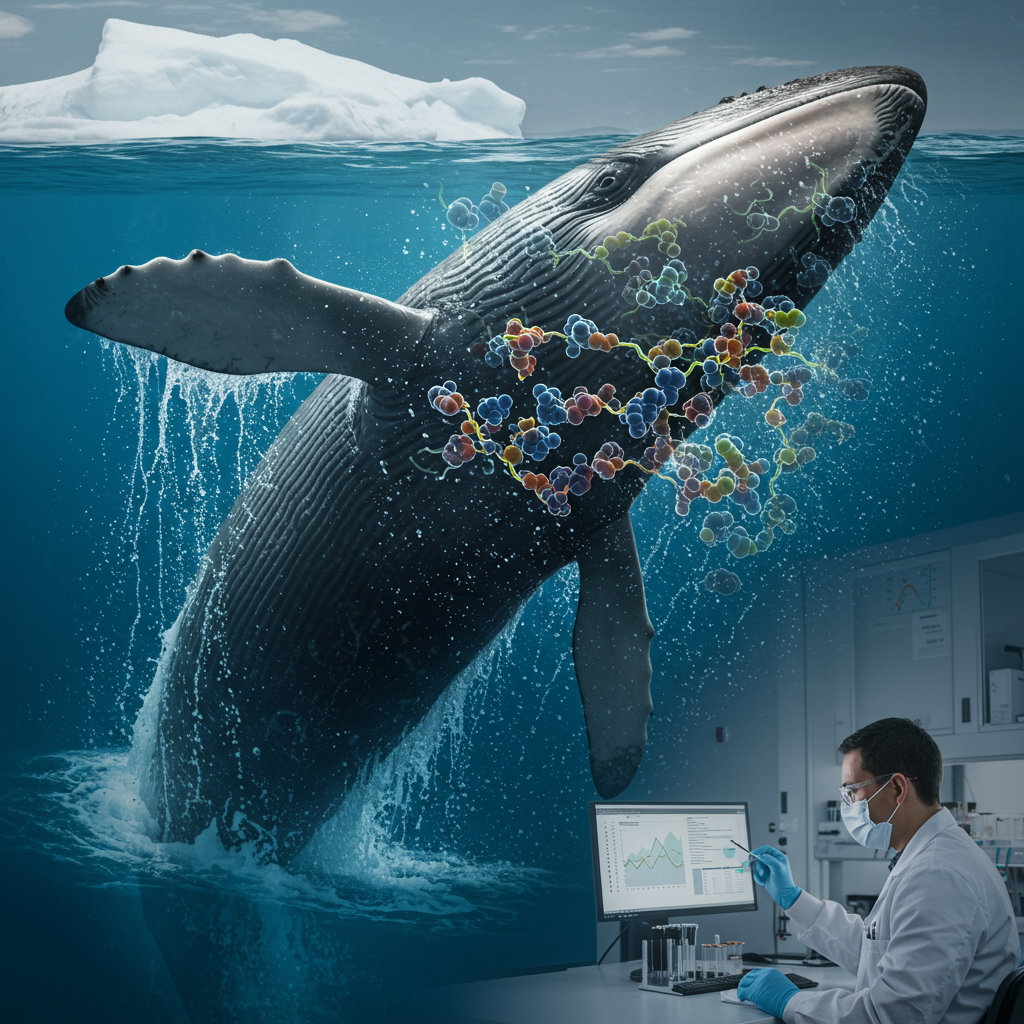For centuries, the majestic bowhead whale has navigated Arctic waters, often living for over 200 years while defying diseases that plague other mammals. As humans grapple with age-related illnesses like cancer, understanding the extraordinary resilience of these marine giants offers profound insights. Recent groundbreaking research from the University of Rochester pinpoints a remarkable protein, CIRBP, as a central player in the bowhead whale’s exceptional lifespan and robust health, potentially unlocking new pathways for human longevity and disease resistance.
Decoding Extreme Longevity: The Bowhead Whale Advantage
Imagine living for two centuries, largely free from debilitating age-related diseases. This isn’t a fantasy for Balaena mysticetus, the bowhead whale. While humans become increasingly vulnerable to conditions like cancer as we age, these colossal creatures exhibit extraordinary resistance, maintaining robust health for an unparalleled lifespan among mammals. This stark contrast has long fascinated scientists: How does such a massive animal, with countless cells dividing over hundreds of years, manage to evade the cellular breakdowns and genetic damage that lead to disease and aging in other species?
Professor Vera Gorbunova, a leading researcher at the University of Rochester, emphasizes the significance of this phenomenon. “This research shows it is possible to live longer than the typical human lifespan,” she notes, highlighting the bowhead whale as a unique model for understanding extreme mammalian longevity. By studying the only warm-blooded mammal known to outlive humans, scientists aim to uncover the precise biological mechanisms enabling such extended healthy lives.
Peto’s Paradox: A Giant Leap in Cancer Resistance
The sheer size and lifespan of bowhead whales present a scientific puzzle known as Peto’s Paradox. The “multi-stage model of cancer” predicts that cancer typically arises after multiple genetic mutations, or “oncogenic hits,” accumulate in crucial genes. Logically, an animal with more cells and a longer life should accumulate more of these hits, leading to a higher cancer risk. Yet, Peto’s Paradox observes the opposite: large, long-lived species like whales and elephants do not exhibit higher rates of cancer compared to smaller animals.
This paradox implies that nature has equipped these giants with superior defense mechanisms against cancer. For instance, elephants, as detailed in The Scientist, possess an astounding 20 copies of the tumor-suppressing TP53 gene, compared to just two in humans. This allows elephant cells to be more sensitive to DNA damage, triggering programmed cell death (apoptosis) to eliminate potentially cancerous cells. Naked mole rats, another longevity champion studied by Gorbunova and Andrei Seluanov, achieve cancer resistance through high molecular weight hyaluronic acid (HMW-HA), which was successfully transferred to mice to extend their lifespan and health.
Intriguingly, bowhead whales don’t rely on TP53 duplications like elephants. Instead, their strategy, as revealed by the University of Rochester team, including Professors Gorbunova and Seluanov, along with first authors Denis Firsanov and Max Zacher, involves a different, yet equally powerful, form of genome maintenance. Their research demonstrated that while human cells typically require five to seven oncogenic hits to become cancerous, bowhead whale cells actually need fewer hits. The critical distinction is that whale cells are “less likely to accumulate oncogenic hits in the first place” due to enhanced protective mechanisms. This insight flips the script on Peto’s Paradox, suggesting prevention, not just suppression, is key.
CIRBP: The Guardian of the Whale Genome
The heart of the bowhead whale’s cancer resistance and extreme longevity appears to lie in a protein called CIRBP (Cold-Inducible RNA Binding Protein). The University of Rochester team, combining genomic data with intricate molecular biology experiments on bowhead whale tissue, investigated proteins involved in DNA repair. Among several DNA repair proteins found in higher abundance in whales, CIRBP emerged as a truly exceptional candidate.
“There were some other proteins that were expressed in bowhead whales at slightly higher levels, but CIRBP stood out because it was present at 100-fold higher levels,” explains Professor Gorbunova. This astounding abundance is crucial because CIRBP plays a vital role in repairing double-strand breaks in DNA. These breaks are one of the most dangerous forms of genetic damage, capable of causing disease and shortening lifespan across a diverse range of species, including humans. By efficiently mending these critical lesions, CIRBP safeguards the whale’s genome, preventing the accumulation of the “oncogenic hits” that lead to cancer and age-related decline.
The study, published in Nature, provides compelling evidence of CIRBP’s protective power. To validate its function, researchers introduced bowhead whale CIRBP into human cell cultures and even fruit fly cells. In both instances, the protein dramatically improved DNA repair capabilities. Even more strikingly, the overexpression of bowhead whale CIRBP in fruit flies directly resulted in an extended lifespan, offering a powerful demonstration of its anti-aging potential.
A “Chilling” Discovery: CIRBP and Cold Adaptation
Further collaboration with scientists studying cold adaptation in animals led to another fascinating insight into CIRBP. The researchers found that CIRBP isn’t just highly expressed in bowhead whales; its production can be stimulated by environmental factors. “If we just lower the temperature a few degrees, cells make more CIRBP protein,” notes Professor Seluanov.
This “chilling discovery” suggests that CIRBP may be intrinsically linked to the bowhead whale’s adaptation to its frigid Arctic habitat. The extreme cold might naturally trigger increased CIRBP production, reinforcing the whale’s robust genome maintenance. While the exact level of cold exposure required to elicit a similar response in human cells remains unknown and highly speculative, it opens intriguing avenues for research into natural ways to boost this protective protein.
Future Horizons: Bridging Whale Biology to Human Health
The discoveries surrounding CIRBP in bowhead whales offer a beacon of hope for human longevity and disease prevention. The University of Rochester team is now actively exploring various strategies to enhance CIRBP activity in humans. These approaches could involve boosting the body’s natural CIRBP production or even introducing the protein directly.
Professor Gorbunova suggests that lifestyle changes, such as adopting practices like cold showers, might hypothetically contribute to increasing CIRBP levels. However, she cautions that these ideas are currently preliminary and require extensive further research to confirm any effectiveness in people. The immediate next step involves rigorous testing of CIRBP to fully understand its potential.
This research underscores that there are diverse evolutionary pathways to improving genome maintenance. The bowhead whale’s unique method of dramatically increasing CIRBP levels presents a novel target for therapeutic development. By understanding and potentially mimicking these powerful natural defense mechanisms, scientists aspire to develop strategies that could one day help humans better resist cancer and slow the effects of aging, leveraging the wisdom of nature’s longest-living mammal.
Frequently Asked Questions
What is CIRBP and how does it contribute to bowhead whale longevity?
CIRBP stands for Cold-Inducible RNA Binding Protein, and it’s a protein found at exceptionally high levels (up to 100-fold more than other mammals) in bowhead whales. Its primary role is to repair double-strand breaks in DNA, which are highly damaging forms of genetic lesions that can lead to disease and shorten lifespan. By efficiently mending this genetic damage, CIRBP helps bowhead whales maintain superior genome stability, preventing cancer-causing mutations and contributing significantly to their remarkable 200-year healthy lifespan.
How does the bowhead whale’s cancer resistance relate to Peto’s Paradox?
Peto’s Paradox describes the observation that large, long-lived animals don’t have higher cancer rates, despite having many more cells and more time for mutations to accumulate. Bowhead whales defy this paradox not by requiring more “oncogenic hits” to develop cancer, but by being “less likely to accumulate oncogenic hits in the first place.” Their superior genome maintenance, largely due to high levels of CIRBP, actively prevents genetic damage from occurring or rapidly repairs it, thus offering a powerful natural defense against cancer development.
Can understanding CIRBP from bowhead whales lead to new human anti-aging or cancer therapies?
Yes, the research into bowhead whale CIRBP holds significant promise for human health. Scientists at the University of Rochester are exploring strategies to increase CIRBP activity in humans, either by boosting the body’s natural production of the protein or by introducing it directly. The goal is to leverage the whale’s unique mechanism for enhanced DNA repair to potentially develop new therapies that could improve genome maintenance, boost resistance to cancer, and slow the effects of aging in humans. While ideas like cold exposure are speculative, the scientific investigation into CIRBP’s therapeutic potential is actively underway.
Conclusion
The bowhead whale’s extraordinary capacity for extreme longevity and disease resistance, particularly its mastery over age-related illnesses, provides a compelling natural blueprint for human health. The discovery of CIRBP as a key player in their advanced DNA repair mechanisms offers a profound scientific breakthrough. While the journey from whale biology to human application is complex and requires extensive further research, the insights gained from these Arctic giants ignite hope. By unraveling the secrets of the bowhead whale’s genome, we move closer to developing innovative strategies that could enhance human health, extend healthy lifespans, and perhaps, one day, redefine our understanding of aging itself.




